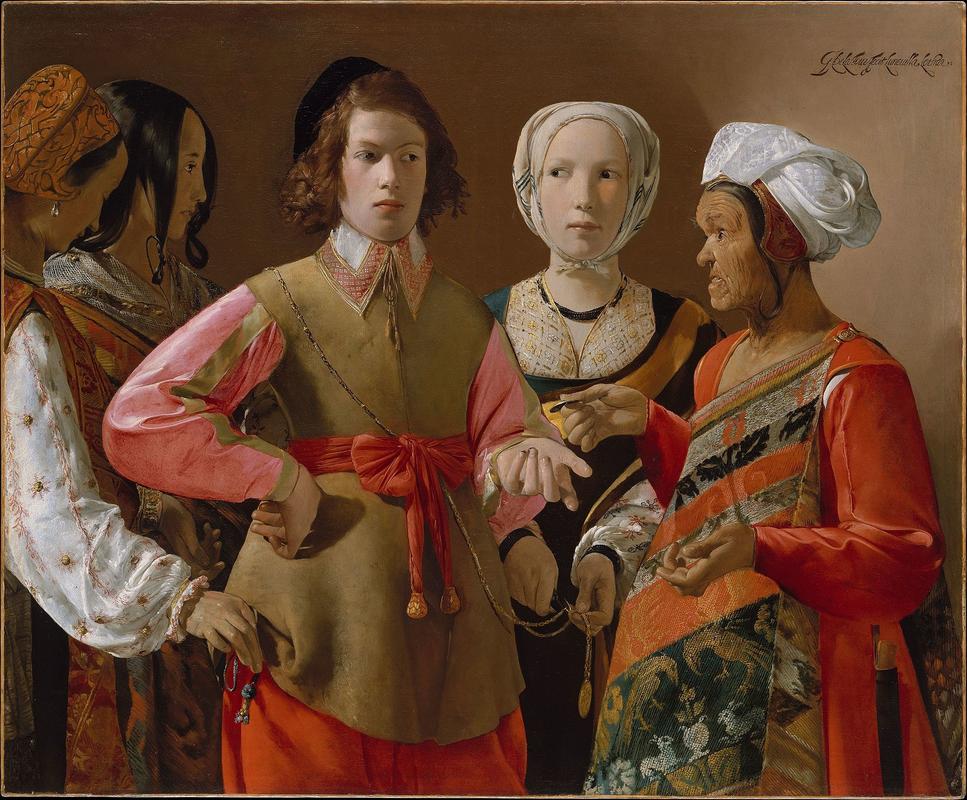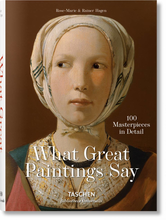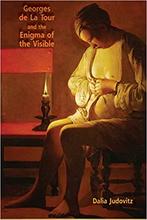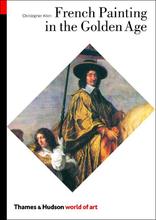More about The Fortune-Teller
- All
- Info
- Shop

Sr. Contributor
Georges de La Tour's The Fortune Teller is throwing major shade
Not only is there shade being thrown among the people in this painting, but The Fortune Teller has been the subject of shade since it first magically surfaced in a private collection in France in 1879 – even though The Metropolitan Museum of Art dates the painting to the 1630s. The painting might be the companion to Cheat with the Ace of Clubs at the Kimbell Art Museum or to Cheat with the Ace of Diamonds at the Louvre. Whatever it is, like the trickery that is the subject of the painting and either of its possible counterparts, this work just might have a few tricks up its own sleeve.
Although The Met has staunchly maintained that it has an authentic, seventeenth-century work by La Tour, there are many scholars who believe that the painting is a 20th-century fake, and there was even a 60 Minutes exposé that aired in 1982 attempting to reveal the painting’s nefarious beginnings. A scandal of this proportion would certainly rock The Met’s street cred as one of the most reputable museums in the world, and there were rumors that The Met was going to sue CBS for this report. But just as the old hag swindles the boy in La Tour’s painting, The Met might be pulling a fast one on art lovers everywhere.
Both sides of the story make good cases, and the fact that actual art scholars believe the painting is indeed fake is pretty alarming. There are a few hints that have led some to believe that The Fortune Teller is a forgery. For one, this particular painting looks vastly different from other works by La Tour. This is a BFD considering there are only thirty-five known works by La Tour today, so there really isn’t a huge body of work to camouflage this not-so-little slip. Scholars have also pointed out that the older gypsy’s costume is too ridiculous compared to other La Tour outfits and doesn’t match with either other contemporary depictions of gypsies from this time or how scholars understood what seventeenth-century gypsies actually wore (hint: not the latest duds from Urban Outfitters). It is also known that, when forgeries do happen, imposters like to hide clues in their fake paintings. “Merde,” or French for shit, was painted into one of the gypsies’ costumes – until The Met removed this little gem in 1982.
Armed with some of the best conservators in the field, The Met retaliated with science. Met conservators figured out that the hidden “merde” was not the work of a forger, but was actually added in by an artist who later restored the painting. Hey, we’ve all had bad days at work, right? To pack another punch, Met conservators went the technical route, just like their haters did. Using X-rays and chemical examinations of the paints used in the work, they discovered that it included a pigment known as lead tin yellow, which artists stopped using after 1750. The scientific discoveries of previous restorations and that specific yellow pigment solidified their case. The Met also relied on the painting’s date of discovery in the late 1870s. If the painting was documented as early as 1879, it couldn’t have possibly been made in the 20th-century. Straight lawyered.
The Met still stands by the work’s authenticity, as it is currently hanging in the museum’s European Paintings galleries, where you can contemplate the questionable history of the painting as you look at the shifty-eyed gypsies who rob the unsuspecting young man.
Sources
- “‘The Fortune Teller’; Murky History?” The New York Times. April 22, 1990. http://www.nytimes.com/1990/04/22/arts/l-the-fortune-teller-murky-histo…. Accessed December 28, 2016.
- De Marly, Diana. “A Note on the Metropolitan ‘Fortune Teller.’” Burlington Magazine Vol. 112, No. 807 (Jun., 1970): 388–389, 391.
- Glueck, Grace. “The Furor Over The Met’s La Tour; News Analysis.” The New York Times. March 24, 1982, http://www.nytimes.com/1982/03/24/arts/the-furor-over-the-met-s-la-tour… Accessed December 28, 2016.
- Rosenberg, Pierre. France in the Golden Age: Seventeenth-Century Paintings in American Collections. New York: The Metropolitan Museum of Art, 1982.
- The Associated Press. “Met Museum May Sue CBS Over Fake-Painting Report.” March 20, 1982. http://www.nytimes.com/1982/03/20/arts/met-museum-may-sue-cbs-over-fake…. Accessed December 28, 2016.
Featured Content
Here is what Wikipedia says about The Fortune Teller (La Tour)
The Fortune Teller is an oil painting of circa 1630 by the French artist Georges de La Tour. The work was uncovered in about 1960 and purchased that year by the Metropolitan Museum of Art in New York.
François Georges Pariset described the painting in The Metropolitan Museum of Art Bulletin, attributing it to La Tour—a likely choice given the calligraphic signature at top right: "G. de La Tour Fecit Luneuilla Lothar" ("G[eorges] de La Tour made this, Lunéville, Lorraine"). Its authenticity has been questioned in the intervening years, notably by the English art historian Christopher Wright, but The Fortune Teller is generally accepted as La Tour's work.
Check out the full Wikipedia article about The Fortune Teller (La Tour)















